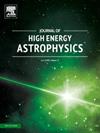On the Hubble expansion in a Big Bang quantum cosmology
IF 10.2
4区 物理与天体物理
Q1 ASTRONOMY & ASTROPHYSICS
引用次数: 0
Abstract
The Hubble expansion of the Universe is considered in the classical limit of a Big Bang quantum cosmology. In an IR-consistent coupling to the bare cosmological constant, we infer a dark energy as a relic of the Big Bang by loss of time-translation invariance on a Hubble time-scale. This dark energy is identified with the trace J of the Schouten tensor permitting an analytic solution . Anchored by the Baryonic Accoustic Oscillations, JCDM predicts a Hubble constant alleviating -tension between the Local Distance Ladder and in ΛCDM, whose dark energy Λ is a constant. Emulated by CDM, a CAMB analysis shows a JCDM fit to the Planck 2018 power spectrum on par with ΛCDM with small positive curvature consistent with Planck-ΛCDM with no extra relativistic degrees of freedom. In late-time cosmology, JCDM is also consistent with the BAO recently measured by DESI. JCDM offers a novel framework to address -tension, predicting background quantities consistent with the uncertainties in BAO measurements and early-Universe observations. It predicts a deceleration parameter , that may be tested with upcoming low-redshift galaxy surveys.
大爆炸量子宇宙学中的哈勃膨胀
哈勃宇宙膨胀被认为是大爆炸量子宇宙学的经典极限。在与裸宇宙常数的红外一致耦合中,我们通过在哈勃时间尺度上失去时间平移不变性来推断暗能量是大爆炸的遗迹。这个暗能量可以用允许解析解H(z)的Schouten张量的迹线J来识别。以重子声学振荡为基础,JCDM预测哈勃常数H0=6/5H0Λ缓解了局地距离梯和ΛCDM中的H0Λ之间的H0-张力,其暗能量Λ是一个常数。由w(a)ΛCDM模拟,CAMB分析显示JCDM拟合的Planck 2018 ClTT功率谱与ΛCDM相当,具有与Planck-ΛCDM一致的小正曲率,没有额外的相对论自由度。在晚时间宇宙学中,JCDM也与DESI最近测量到的BAO一致。JCDM提供了一个新的框架来解决h0张力,预测与BAO测量和早期宇宙观测的不确定性相一致的背景量。它预测了一个减速参数q0≃−1,可以在即将到来的低红移星系观测中进行验证。
本文章由计算机程序翻译,如有差异,请以英文原文为准。
求助全文
约1分钟内获得全文
求助全文
来源期刊

Journal of High Energy Astrophysics
Earth and Planetary Sciences-Space and Planetary Science
CiteScore
9.70
自引率
5.30%
发文量
38
审稿时长
65 days
期刊介绍:
The journal welcomes manuscripts on theoretical models, simulations, and observations of highly energetic astrophysical objects both in our Galaxy and beyond. Among those, black holes at all scales, neutron stars, pulsars and their nebula, binaries, novae and supernovae, their remnants, active galaxies, and clusters are just a few examples. The journal will consider research across the whole electromagnetic spectrum, as well as research using various messengers, such as gravitational waves or neutrinos. Effects of high-energy phenomena on cosmology and star-formation, results from dedicated surveys expanding the knowledge of extreme environments, and astrophysical implications of dark matter are also welcomed topics.
 求助内容:
求助内容: 应助结果提醒方式:
应助结果提醒方式:


